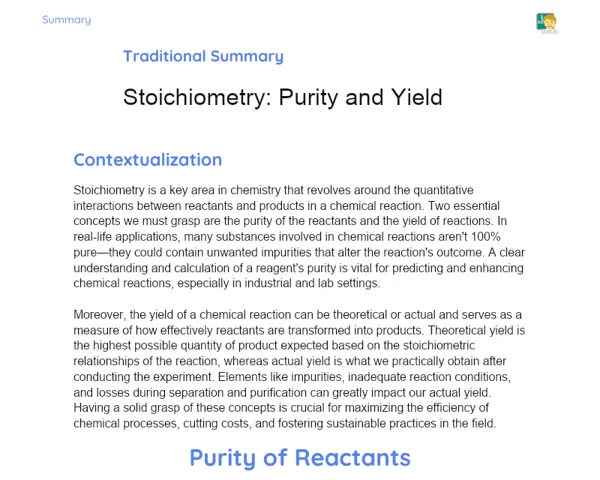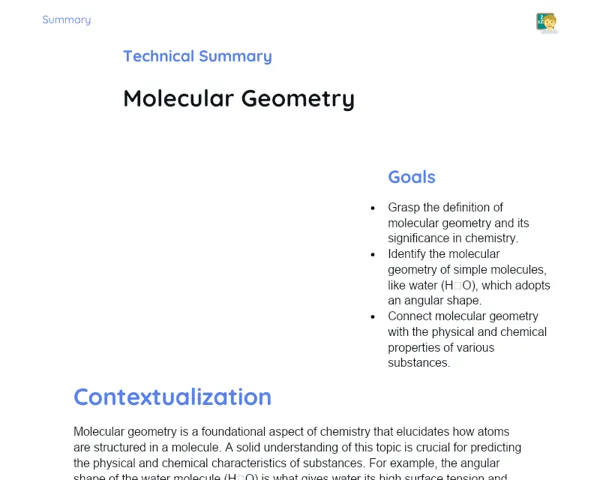Socioemotional Summary Conclusion
Goals
1. Identify the molecular geometry of different molecules, like the bent shape of water.
2. Understand the physical and chemical properties that stem from molecular geometry.
Contextualization
Did you know that the arrangement of atoms in a molecule can dictate whether it’s solid or liquid at room temperature? For example, water has a bent molecular shape, which gives it unique qualities, such as its ability to dissolve a variety of substances and sustain life on Earth. Let's dive into how slight tweaks in the 'dance' of atoms can create significant effects in our surroundings!
Exercising Your Knowledge
Molecular Geometry
Molecular Geometry refers to the three-dimensional arrangement of atoms within a molecule. This configuration plays a crucial role in defining many of the physical and chemical properties of the substance. For instance, the bent shape of the water molecule allows it to exhibit unique surface tension and solubility characteristics. Think of molecular geometry as the choreography of a dance, where every position or movement of the dancers (atoms) creates a pattern that affects the overall performance.
-
Three-Dimensional Arrangement: Molecular geometry deals with how atoms are positioned in three-dimensional space, which is essential for understanding molecular interactions.
-
Influenced Properties: The shape of a molecule determines its properties, like melting and boiling points, solubility, and chemical reactivity.
-
Visual Analogies: Drawing parallels between molecular geometry and dance or architectural design can enhance comprehension of this abstract concept.
Valence Shell Electron Repulsion Theory (VSEPR)
VSEPR Theory is a model that predicts the geometry of molecules based on the repulsion between electron pairs. According to this theory, electron pairs around a central atom repel each other and position themselves to lessen this repulsion, staying as far apart as possible.
-
Principle of Repulsion: Electron pairs repel one another, positioning themselves as far apart as possible to minimize repulsive forces.
-
Geometry Prediction: VSEPR Theory allows us to forecast the molecular geometry of different substances, which is fundamental for understanding their reactivity and physical properties.
-
Practical Applications: An understanding of this theory is beneficial for grasping chemical reactions and designing new materials and pharmaceuticals.
Molecular Geometry Models
Molecular geometry models, like linear, angular, trigonal planar, tetrahedral, etc., are concepts that aid in visualizing and grasping the shapes of molecules. These models not only support theoretical understanding but are also crucial for the practical application of chemical knowledge.
-
Standard Models: Linear, Angular, Trigonal Planar, Tetrahedral, and others represent standard molecular geometry models.
-
Practical Examples: Molecules like CO₂ (linear), H₂O (angular), and CH₄ (tetrahedral) exemplify these models.
-
Visual Importance: Employing physical or virtual models to visualize molecular geometry can significantly enhance student comprehension and practical application.
Key Terms
-
Molecular Geometry: The three-dimensional arrangement of atoms in a molecule.
-
VSEPR Theory: A model that utilizes electron pair repulsion to predict molecular geometries.
-
Linear: A molecule with atoms arranged in a straight line.
-
Angular: A molecule where atoms form an angle with each other.
-
Tetrahedral: A geometry where atoms are organized in a tetrahedral shape around the central atom.
For Reflection
-
How can understanding molecular geometry enhance our awareness of our own emotions and thoughts?
-
In what ways did collaborating during the creation of molecular models help you develop social-emotional skills like empathy and teamwork?
-
What strategies did you use or could you employ to handle emotions such as frustration or joy during this activity? How can those strategies be applied in other areas of your life?
Important Conclusions
-
Molecular Geometry is the three-dimensional arrangement of atoms in a molecule, which significantly influences its physical and chemical properties.
-
VSEPR Theory assists us in predicting molecular geometries based on the repulsion between valence electron pairs.
-
Molecular geometry models, including linear, angular, and tetrahedral, are essential for understanding the reactivity and properties of molecules.
-
Grasping molecular geometry is important not only for chemistry but also for nurturing social-emotional skills such as teamwork and emotional regulation.
Impacts on Society
Molecular Geometry directly affects our daily lives. For instance, the angular form of water gives it unique dissolving capabilities that are vital for life on Earth. Everyday products like medicines are also formulated based on this knowledge, improving our quality of life. In addition, understanding molecular geometry allows us to anticipate and manage chemical reactions, which is crucial across various industries, from food to technological advancements. In this regard, the ability to understand and apply molecular geometry fosters innovation and scientific progress. For students, this not only widens their career prospects but also enhances their ability to collaboratively solve complex problems while maintaining emotional balance. Recognizing and managing emotions during scientific inquiry is a skill applicable to all areas of life, promoting overall emotional well-being.
Dealing with Emotions
To manage your emotions while studying Molecular Geometry and its applications, I suggest an exercise based on the RULER method. Whenever you hit a roadblock, take a moment to acknowledge the emotions you’re feeling, whether it’s frustration, curiosity, or excitement. Next, try to identify what’s causing these emotions. Remember to label them accurately: for instance, it could be frustration from difficulty in building a model. Express these feelings in a healthy manner, like confiding in a friend or journaling. Finally, practice regulating these emotions, perhaps by taking a break, breathing deeply, or seeking help. This exercise will enable you to remain calm and focused, not just in your studies but in any tough situation.
Study Tips
-
Review molecular geometry content using physical models or online 3D visualization tools to make studying more interactive and engaging.
-
Form study groups with classmates to discuss and build molecular models together. Sharing knowledge and collaborating enriches your understanding.
-
Employ analogies and comparisons, such as the 'dance of atoms,' to clarify more abstract concepts. This will help with memorization and understanding of the topic.



